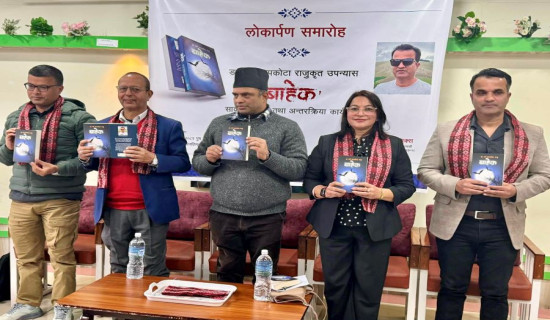- Saturday, 20 December 2025
Nepal In Dire Need Of Int'l Standard Football Stadium
The Asian Football Confederation (AFC), in February, declared that Nepal’s sole international-standard football stadium, Dasharath Rangasala in Kathmandu, no longer meets international standards.
Consequently, the AFC, the governing body of Asian football, suspended international matches at the venue. This decision forced Nepal to play its home matches for the FIFA World Cup Asian Qualifiers against Bahrain and the UAE on foreign soil in March. The move disappointed thousands of Nepali football fans, who could not physically support their team.
However, the Asian football governing body reversed its decision and permitted the venue to host the AFC Challenge League playoff match between Nepal's league champion Church Boys United and Bhutan's league champion Paro FC on August 13. It was speculated that the suspension of the stadium was completely revoked. Nevertheless, this was not the case.
Suresh Shah, spokesperson for the All Nepal Football Association (ANFA), said, "Different tournaments have different stadium standards. Dasharath Rangasala was approved for this match after inspection by League officials. However, future tournaments will require separate inspections." Recently, renowned Asian footballer Keisuke Honda of Japan highlighted how outdated Nepal's Dasharath Rangasala is compared to international football grounds after training and playing here for Paro FC.
The difficulties faced by the players during the AFC League on Tuesday due to the muddy and watery surface suggested that the ground would be unfit for further international matches.
According to sources, the suspension by the AFC was also based on safety concerns of fans and inadequate emergency evacuation procedures at the stadium. This suggests the stadium requires extensive renovation, or possibly reconstruction, to meet international football governing bodies' standards. The AFC Stadiums Regulations provisions the need for proper facilities for team officials, broadcast partners and media, spectators, and commercial affiliates.
Similarly, the regulation stresses the need for proper entry/exit gates to avoid congestion and ensure the smooth flow of spectators, followed by clearly visible signage to guide spectators to sanitary facilities, concessions, retail outlets, exits, and other customer service.
The condition of the existing stadiums in Nepal does not meet both AFC and FIFA standards for all but friendly games.
Following the suspension in February, the National Sports Council and Ministry of Youth and Sports initiated the development of guidelines for nationwide stadium operations. This process is ongoing. Meanwhile, the Karnali Sports Development Council may establish operational guidelines for Surkhet Rangasala ahead of the 10th National Games in November.
Nepal does have other football stadiums, including Pokhara Rangasala, the nearly completed Surkhet Rangasala, Itahari's Regional Stadium, and Biratnagar's Sahid Rangasala. However, these venues are unlikely to meet all international stadium standards.
On July 15, 2024, Nepal's sporting community celebrated a significant development. The first cabinet meeting of the newly formed government under Prime Minister KP Sharma Oli prioritised upgrading the TU International Cricket Ground to a proper stadium within 300 days.
Past unfulfilled promises have tempered cricket fans' excitement over the recent stadium upgrade decision. However, the government's continued engagement post-announcement offers a glimmer of hope.
For a developing country like Nepal, substantial investments in sports may seem impractical. Yet, when funds are allocated to less critical infrastructure, the sports community feels justifiably neglected, given the sector's high demand.
Approximately three dozen sports in Nepal await adequate investment, resources, and infrastructure. Volleyball, showing recent promise and holding national sport status, merits special attention. Cricket is poised to gain multiple international-standard stadiums.
Nepali athletes have excelled in martial arts such as karate, taekwondo, and wushu at the South Asian level. However, they require advanced resources to compete globally. The absence of a national training facility hinders the progress of various athletes, including runners, jumpers, throwers, and weightlifters, in improving their fitness and performance.
The state now faces an additional burden that could have been avoided. Regular maintenance, restricting non-sports activities, and timely upgrades of Dasharath Stadium would have allowed Nepalis to support their national football team against Bahrain and the UAE in person rather than through screens.
This situation shouldn't be taken lightly. Football remains the pinnacle of sports in Nepal, unmatched in popularity, skill level, and entertainment value. Despite the growing fanbase for cricket and volleyball, football's appeal in Nepal is unparalleled.
A well-managed stadium can become self-sustaining by hosting regular matches. Organising A, B, and C-Division matches outside Kathmandu Valley could help regional stadiums thrive and generate funds for upgrades.
If fans from outside the Kathmandu Valley can join easily at the matches to support their clubs, it would strengthen their esteem towards football. This could transform the sport into a viable livelihood for thousands of players, officials, and staff while nurturing a sense of ownership among fan followers across the nation.
(Poudel is a sports journalist at The Rising Nepal.)



-original-thumb.jpg)













